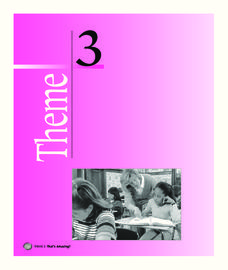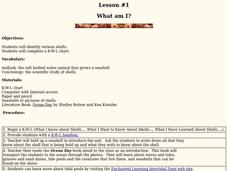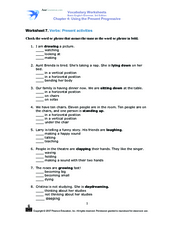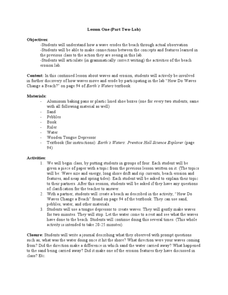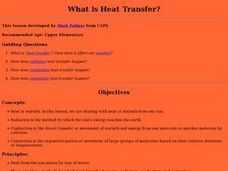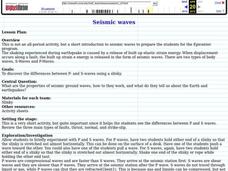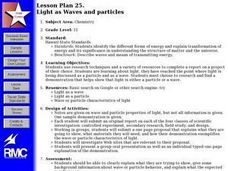Curated OER
Typical Numeric Questions for Physics I - Photoelectric Effect
As the title implies, here is a collection of typical photoelectric effect problems that physics learners need to be able to solve. They determine the amount of energy of a photon, the photons produced per second, the frequency required...
CK-12 Foundation
Seafloor: Sonar Boats
An interactive that teaches about sonar sure sounds like fun! Junior oceanographers study the uses of sonar, past and present, in an engaging interactive. The content demonstrates how sonar works, why sound waves are a great tool...
Houghton Mifflin Harcourt
That’s Amazing!: English Language Development Lessons (Theme 3)
That's Amazing! is the theme of an English language development unit created by Houghton Mifflin. Following a speak, look, move, and listen routine, scholars delve into topics; seasons, weather, animals, landforms, telling...
Curated OER
Sound Busters
Fourth graders engage in a study of sound pollution at their school. After a class discussion on what noise pollution is, learners are asked if they think there are areas of their school or community where noise pollution is a problem....
Curated OER
Wave Actions
In this waves worksheet, students read about the ways waves react depending on the boundary they encounter. They read about natural frequency, resonance, phases and interference in waves. They match 13 terms with their definitions, they...
Curated OER
Tsunami! Examining Earth's Most Destructive Waves
Learners investigate just what a tsunami is, what causes it, how fast it travels, what it looks like, and its devastating effects upon landfall. They read the experience of a former Peace Corps Volunteer who went to Sri Lanka after it...
Curated OER
Wave Action
In this wave learning exercise, students compare the different ways a wave can react: absorption, reflection, refraction, and diffraction. Students also read about constructive and destructive interference. This learning exercise has 13...
Curated OER
What Am I?
Students identify various shells. In this oceanography lesson, students create a KWL chart to activate background knowledge on shells. Students read the book Ocean Day and learn about waves, tides, and the seashells that can...
Curated OER
How is Chess Played?
Students discover how to play chess. In this how is chess played instructional activity, students examine the rules, vocabulary, and tactics of the game of chess.
Curated OER
NUMB3RS Activity: Riding the Waves
High schoolers use the TI-Navigator system to explore vector fields and make predictions. They also identify what a vector field is and that it represents the movement of water. Pupils try to determine where a bottle floating might have...
Curated OER
The Color Spectrum
What is a color spectrum? Simple, it's comprised of the colors of the rainbow. Have the classs read a passage about the color spectrum and then complete two short answer activities.
Curated OER
Using the Present Progressive
What is the present progressive, and how does it change a verb's meaning? There are eight sentences on this worksheet, and each contains a verb already in the present progressive. The pupil studies the bolded word (in present progressive...
Curated OER
Chandra Spies the Longest Sound Wave in the Universe!
In this black hole worksheet, students use an x-ray image and a sound waves image to determine the size and the wavelength of the sound wave. This worksheet has 3 problems to solve.
Curated OER
Measuring the Speed of a Wave
Students create an experiment in which they measure the speed of a wave and record the data in a graph. They work in small groups to write the procedure for the experiment and share it with another group for cross checking of the...
Curated OER
How Do Waves Change a Beach?
Students conduct an experiment on beach erosion. In this earth science lesson plan, students create a beach model and use tongue depressor to produce waves. They write a journal about their observations.
Curated OER
My World is Upside Down
Students observe a demonstration on light. They construct a pinhole viewer, and explore and discuss the concept that light travels in a straight line.
Curated OER
Hear the Wave!
Students study sound and ear function. In this sound functions instructional activity, students investigate soundwaves by completing various experiments. Students participate in a number of sound stations and complete the comparison...
Curated OER
Seismic waves
Students discover the differences between P- and S-waves using a slinky. They see that when displacement occurs along a fault, the built up strain of energy is released in the form of seismic waves.
Curated OER
Light as Waves and Particles
Eleventh graders explore the wave and particle properties of light.
Curated OER
Waves: Understanding the Motion of Waves
Young scholars demonstrate the motion of waves. In this wave lesson, students demonstrate the various attributes to waves and the properties through a variety of hands-on activities.
Curated OER
Transverse Wave Demonstrator
Students discover the properties of waves in Chemistry and Physics. In groups, they develop and build their own device to demonstrate transverse waves. They complete their tests, record the results and discuss the conclusions with the...
Curated OER
Ride the Wave!
Young scholars examine how sonar works. They discuss the concept of sound waves, observe a demonstration of how sonar works using water, pie plates, and eyedroppers, and describe how sonar works in their own words.
Curated OER
Earthquakes: Second Grade Lesson Plans and Activities
What causes earthquakes? Second graders learn about stresses from plate movement with a set of hands-on activities. After tracing fault lines on a map with yarn, class members create a paper plate model of Earth to show its layers...


